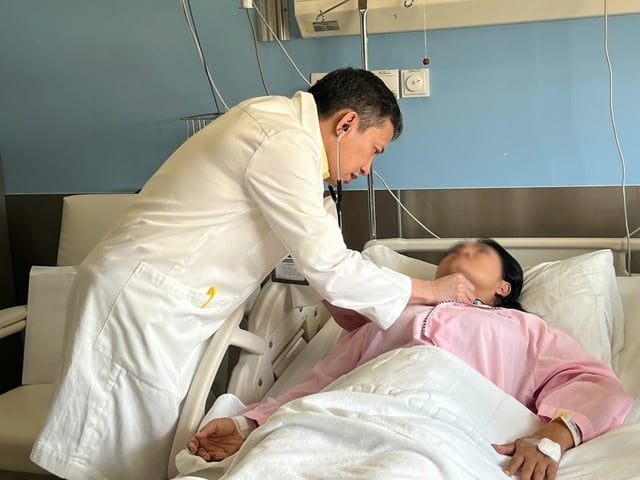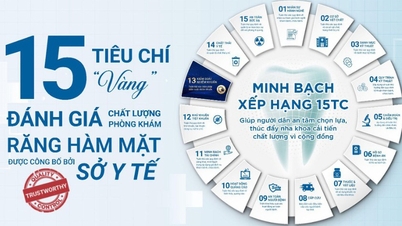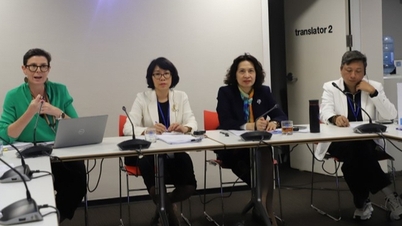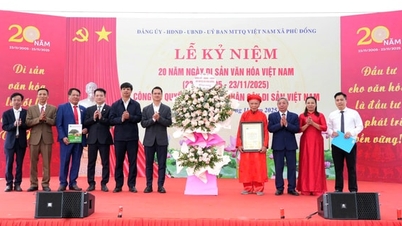It was not until she came to Vietnam and visited FV Hospital that the cardiologists there discovered the cause of a rare genetic lipid disorder, and from there developed a comprehensive treatment regimen to help her escape the critical condition and prevent future coronary artery re-narrowing.
Transient heart pain reveals coronary artery disease
One morning two years ago, Ms. KS. suddenly felt a sharp pain in her heart while cycling. The pain was fleeting, but when she went to a local hospital in Cambodia, it turned out to be a warning sign of a dangerous heart disease that was silently progressing: an X-ray showed that she had a completely blocked coronary artery, preventing blood from fully supplying the heart, reducing the heart's contractility.
The following months were Ms. S.'s treatment journey in many hospitals in her hometown, even abroad. Although she was examined and given medicine by doctors, the results were not very positive. Her heart palpitations and difficulty breathing became more and more serious.
Following the advice of a Cambodian doctor, she went to Vietnam and went to FV Hospital - which owns a modern Cardiovascular Center, regularly receiving complicated cases not only from Vietnam but also from neighboring countries, especially Cambodia.

Young patients can still suffer from dangerous coronary artery disease due to lipid disorders. Photo: Freepik
After examining Ms. S., Dr. Ho Minh Tuan - Head of Cardiology & Interventional Cardiology, FV Hospital, determined that she had chronic complete blockage of the coronary artery due to atherosclerosis.
Coronary artery stenosis due to atherosclerosis is not common in people under 50 years old like Ms. S., so Dr. Tuan suspected that this disease was caused by another cause. After carefully studying the patient's medical records and having the patient do additional tests, the head doctor traced the origin of the coronary artery occlusion to a rare genetic lipid disorder syndrome. The failure to thoroughly treat the cause of the disease was the reason why Ms. S.'s condition did not improve, because the risk of re-stenosis was very high.
" 2 in 1" plan : coronary artery revascularization and control of the cause of the disease
Dr. Ho Minh Tuan developed a comprehensive treatment plan for patient S. including two phases: coronary revascularization intervention and blood lipid index control.
The coronary revascularization intervention for Ms. S. was performed in the Cathlab with the support of DSA and OCT, clearly showing the size and shape of the blocked blood vessel branch. Dr. Tuan inserted a tube into the blood vessel, reached the blocked blood vessel, broke the atherosclerotic plaque, dilated the balloon and placed 2 stents to clear the patient's blood vessel. The entire intervention process took about 1 hour.

Dr. Ho Minh Tuan (right) and the team placed a stent and reopened the patient's coronary artery. Photo: FV
Dr. Ho Minh Tuan said that Ms. S. was lucky because she was treated promptly. If left too long, the heart's squeezing force would decrease due to insufficient blood supply to the heart; symptoms of fatigue, heart palpitations and chest heaviness would become more severe, even leading to fainting.
Next, Ms. S. continued to receive treatment to control blood lipid disorders. Dr. Tuan prescribed oral and injectable medications to lower blood lipid levels, combined with a nutritional regimen, physical exercise, mental relaxation, and improved sleep. The patient's health condition then stabilized, with no more heart attacks or shortness of breath. Cardiovascular indicators such as heart rate and blood pressure were stable during follow-up visits.
"When risk factors are well controlled, the rate of coronary artery stenosis recurrence is very low, only less than 1%," said Dr. Tuan.
"I thank Dr. Tuan for finding the exact cause of my illness and successfully treating me. Thanks to the doctor, I no longer feel tired or have chest pain," Ms. KS emotionally shared on the day of discharge from the hospital.

Dr. Ho Minh Tuan examined Ms. KS before preparing to be discharged from the hospital. Photo: FV
When coronary artery stenosis is no longer a disease of old age
Dyslipidemia (genetic and acquired) is a condition in which high blood lipids accumulate in the walls of blood vessels, causing coronary artery disease, leading to many cardiovascular health problems. What is alarming is that this problem is not uncommon in young people but is often overlooked. According to Dr. Tuan, young patients diagnosed with coronary artery stenosis at FV will be further tested for specialized blood lipid index so that if there is a problem, it can be thoroughly treated.
Thanks to pioneering the application of modern cardiovascular intervention techniques, keeping up with world medical advances, FV Hospital regularly receives and successfully treats complex cardiovascular emergencies transferred from hospitals in Ho Chi Minh City, neighboring provinces and neighboring countries.
In particular, FV owns a 24/7 Golden Hour myocardial infarction emergency team with the "70 golden minutes" procedure in cardiovascular emergency, following JCI quality - the world's strictest patient safety standards. Thanks to that, many patients in critical emergency conditions have been saved and have made spectacular recoveries.
At the same time, to help patients recover quickly from cardiovascular complications, FV Hospital also built a separate Cardiovascular Rehabilitation team with the coordination of interventional cardiologists, physical therapists and nurses along with specialized machines.
For more information about coronary artery stenosis treatment at FV Hospital, readers can contact 06 Nguyen Luong Bang, Tan My Ward (old District 7), Ho Chi Minh City or by phone (028) 35 11 33 33. Emergency hotline (028) 35 11 35 00.
FV Hospital
Source: https://suckhoedoisong.vn/2-nam-bi-tac-mach-vanh-khong-khoi-nu-benh-nhan-tre-duoc-bac-si-fv-truy-tan-goc-can-nguyen-va-tri-dut-diem-169251120170727606.htm














































































































Comment (0)